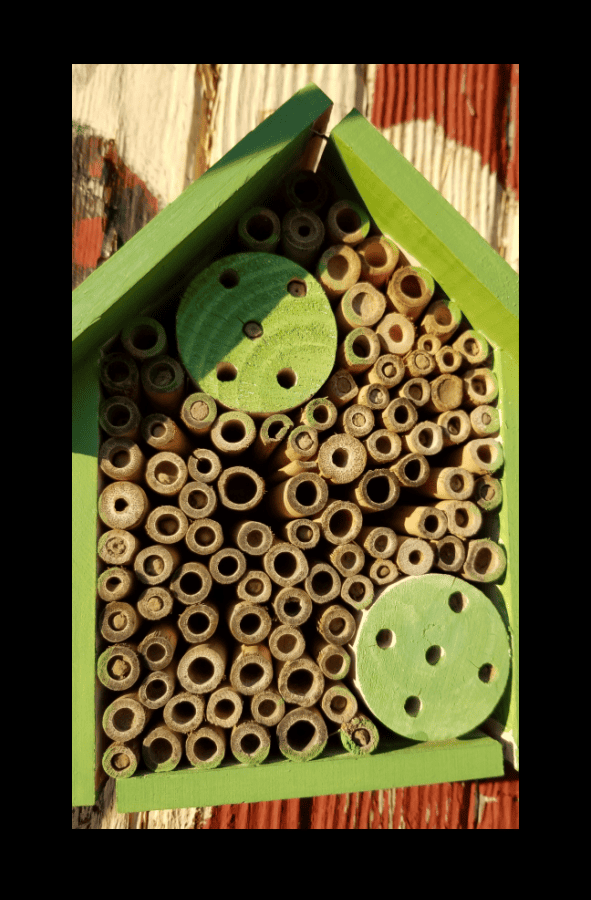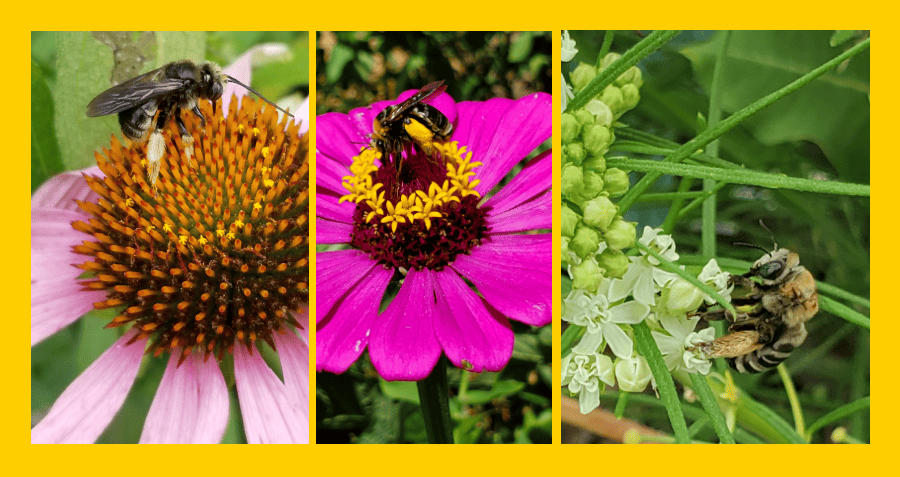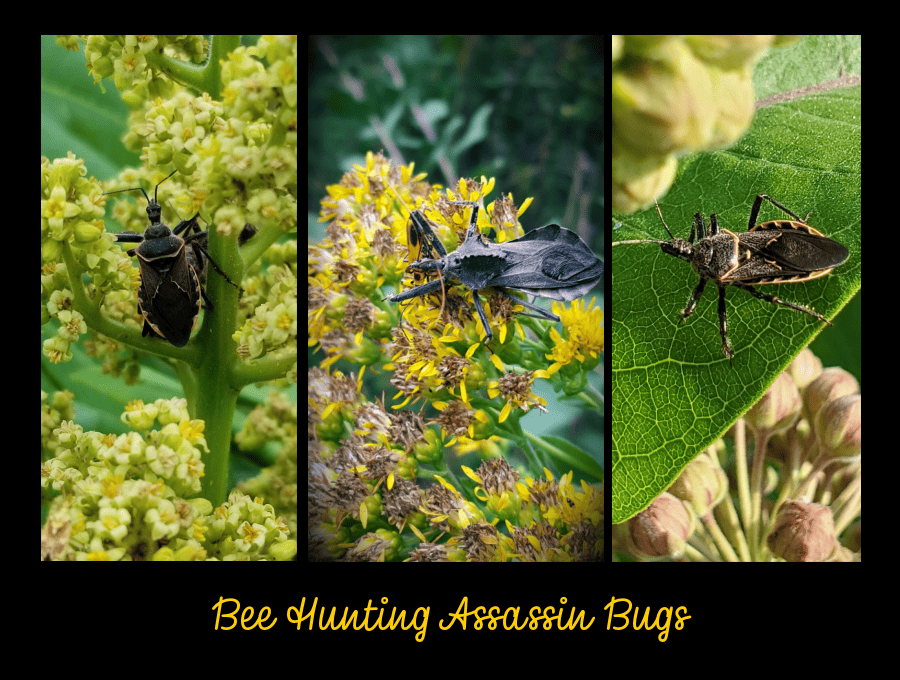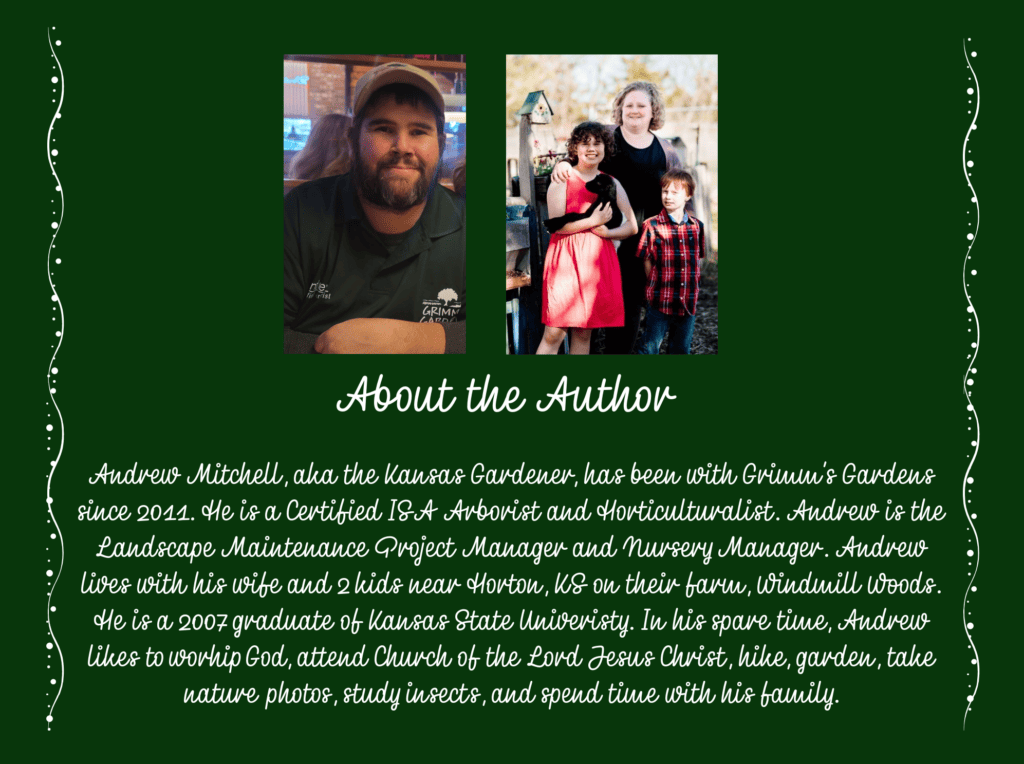As the winter turns into February, I begin to really long for spring. And the native bees are the first pollinators to arrive. On dandelions, toothwort, dicentra, and other early spring wildflowers, I see native bees. There are around 4,000 native bees in the United States and about 400 in Kansas. And it may be difficult to find them. For context, iNaturalist is the foremost place to record and identify wildlife. In in Kansas thus far, about 90 species of bees (including the western honeybee) have been identified. On my own, I have 29 species of native bees.
Why are native bees so important? A lot of talk is on honeybees, foulbrood, and colony collapse disorder. But that is because honeybees are like cows, they are farmed and they make a profit for people. Native bees do the pollination work for free, and ask nothing in return except something to pollinate and a place to have a home. But they do not produce honey.
The Role of Native Bees
What do our native bees do? They pollinate. And most of them are specialists, choosing to pollinate a set group or genus of plants. Some of them are broader in their choices too, like the bumblebees, sweat bees, and mason bees. And because bees are pollinators, they need to be protected. Did you know that just a few hundred mason bees can pollinate 1 acre of apples? It takes several thousand honeybees to do the same thing.
Honeybees, though living in both human made homes and in the wild in trees and structures, do not pollinate as many things as our native bees do. Nor do honeybees do it as well. This is why we must work harder to protect the bees, butterflies, bats, beetles, bugs, moths, wasps, and other pollinators from becoming a distant memory.
Besides pollination services, many bees are prey to a wide variety of other insects, as well as birds. I do not have a problem with bee hunting wasps, spiders, or birds. Mainly because many of these predators are also eating pests. All the pollinators, prey, and predators working together re what makes the ecosystem balance out. When you get and intruder (like Emerald Ash Borer or Spotted Lanternfly), the ecosystem is out of balance. The same is true if you lose a key player (like bumblebees or spider wasps).
How Can Gardeners Protect and Promote Bee Diversity?
There are a lot of things we can do the keep native bees in the garden and landscape. Firstly, we need to become aware of what bees and other insects are supposed to be in our region. What good is trying to protect something if you do not know what it is and what is needs? There are many resources to help you learn about the bees and other ecosystem players. I recommend the books Pollinators of Native Plants by Heather Holm, Attracting Native Pollinators by the Xerces Society, Our Native Bees by Paige Embry, and Bringing Nature Home by Doug Tallamy as a place to start.
Next, we can lay off the pesticides, herbicides, and fungicides in the garden. This might be a bit overwhelming for many of you. And especially for those battling EAB, Spotted Lanternfly, Japanese beetle, Asian Longhorned Beetle, or any other invasive, nonnative pest. But by promoting more insect diversity with the stopping or reduction of pesticides, you will get predators that eat those other insects. For example, since the arrival of Japanese beetles into my landscape around 2018, I have seen a significant increase in the number and diversity of assassin bugs and predatory insects. In my backyard alone I counted 9 species of assassin bug in 2023. Most people do not know about any except the wheel bug!
Third, increase biodiversity of the plant species in your landscape. My wife is pushing me to remove the turf from our yard, to plant more vegetables and flowers. And I intend to do so, while increasing the biodiversity of my garden even more. Plant more of each category each year; annuals, perennials, grasses, shrubs, and trees. And try to plant as many things as you can that are host plants for butterflies and moths.
And finally, provide homes. There are many native plants, perennials and grasses mainly which have hollow stems that bees nest in. Also, leaves some bare patches on the ground for those ground nesting bees. The best way to do that is to create meadow gardens which are un-mulched. Using plants that have bunching type root systems leaves spaces for bare ground and those bees.

Homes for Native Bees
Because they do not produce honey, they do not need specialized homes to live in. Native bees nest in a variety of places. One way to provide homes for some of them, such as the mason bees, is to tie some short (6in to 10in) pieces of 1/4 inch diameter bamboo together. Your can make a special bee “hotel” by just adding a roof to the aforementioned bundle. Many places now sell these bee hotels in the spring, and some sell them year-round. But you can make them just as easily.
Many other bees nest in the hollow stems of perennials and grasses. How do you protect those homes? By waiting as long as possible to remove them from the landscape in late winter or early spring. Most recommend waiting until May. But if you need to cleanup your garden early, cut the stems at ground level, and move them to another place on your property where the bees and other overwintering insects can still slumber and emerge at the correct time. I cut all my grasses down in my Monarch Waystation in February, and move them across the drive to brush pile. (Brush piles are also a good place for native bees and other wildlife to live).
Plants With Hollow Stems for Overwintering Insects
Try to grow at least a few of these plants in your garden for native bees and other insects to nest and overwinter in. There are cultivars of most of these plants, which also have hollow stems.
- Purple coneflower – Echinacea purpurea
- Beebalm – Monarda species
- Mountain mints – Pycnanthemum species
- Switch grass – Panicum virgatum
- Indiangrass – Sorghastrum nutans
- Big Bluestem – Andropogon gerardii
- Ironweed – Vernonia species
- Hummingbird Mint – Agastache species
- Swamp Milkweed – Asclepias incarnata
- Blazingstars – Liatris species
- Goldenrods – Solidago species
- Culver’s Root – Veronicastrum virginicum
Some Common Native Bees
Green Sweat Bees – Agapostemon
If you see a green blur at the flowers, you are probably looking at a green sweat bee. However, there are some cuckoo wasps with similar colors and markings, but they are even faster. There are about 43 species of green sweat bees in North America. Though these are called sweat bees, they are not attracted to human sweat, like some of the other types of sweat bees. They just resemble them in appearance. Most nest in solitarily in the soil.

Sweat Bees – Augochlora
With a total of 122 species in North America, these bees are quite common on flowers in the Central Great Plains. Just like the green sweat bees, they are often metallic in color and also are not attracted to human sweat. They can be green, blue, or bronze colored. Species in this genus may make nests in rotting wood or use pre-existing tunnels.

Leafcutter Bees – Megachile
These bees are fascinating to watch. I could stand for hours just to see one of these little bees fly up to a redbud or rose leaf, and cut a near perfect circle from it just to line their nest with. They are also quite common in my garden on a variety of flowers. There are 140 species in North America of these native bees. Nearly all of them use preexisting tunnels from abandoned beetle nests, hollow stems, or other tunnels for nesting.

Longhorned Bees – Melissodes
There are around 120 species in this genus of native bees in North America. I see longhorned bees quite often in midsummer and later, on Liatris especially. They get their name from the long antennae of the males. Often very hairy, most species prefer to forage on members of the Aster Family of plants. They all nest in the ground.

Sunflower Longhorn Bees – Svastra
Despite there being only 15 species of these in North America, I see them often in my garden in late summer. They appear to have shaggy legwarmers on all the time. Most of the species make solitary nest in the ground.

Bumblebees – Bombus
One of my favorite groups of bees. I see lots of these. And they come out earlier than any other bee, except small mining bees and some of the sweat bees. There are about 50 species in North America, and some of them are quite rare. Often, I look for bumblebees more than other bees, because I am seeking out rare ones in my area. These bees nest socially in small colonies. Sometimes they may use preexisting spots, such as when a colony used an empty ammo box in my yard.

Large Carpenter Bees – Xylocopa
If you are a homeowner, you have likely had run ins with the large carpenter bees as they drill holes in your deck or wood siding. They are large, and have the appearance of a shiny bumblebee. But they nest in wood cavities, which is why they are called carpenter bees. But all you need to deter them is a good coat of paint.

A Few Special Native Bees From My Yard
These are just a few of the many bees I have observed in Northeast Kansas. I say special, but they may not be to entomologists. I just find them more interesting when they are less common.
- Concave Longhorn-Cuckoo bee, Triepeolus concavus, a member of the Cuckoo Bees. These bees do not make their own nests. Instead, they lay an egg in a longhorned bee nest, and the hatching larvae kills the larvae or egg of the longhorn bee.
- Hibiscus Turret Bee, Ptilothrix bombiformis, a species of chimney bee. They are solitary ground nesters which live in communities and build turrets over their holes.
- Dark Winged Blood Bee, Sphecodes gibbus, is a member of the sweat bees, though it is a parasite of other bees. The female enters a host bee’s tunnel or nest, eats its egg and then lays its own egg in the nest. These nests are already fitted for the young bees with pollen and nectar.
Pollinator Plants For Native Bees
Most of our native bees are pollinator specialists, meaning they pollinate or gather nectar from a family or genus of plants rather than go from one plant to another regardless of flower type. This is why it is important to have a diversity of plants, especially natives and nativars in your garden. When planning gardens, whether for pollinators, wildlife, or just your own enjoyment, it is best to choose from a diverse group of plants. One way to do that is to choose plants from several plant families.
While almost anything with an open flower can be pollinated by bees, there are specific plants that you may need to have just to keep bees happy. These plants provide the nectar and pollen necessary for natives bees to thrive and continue their life cycles.
Parsley Family – Apiaceae
Members of this group of plants have flowers arranged in umbels, though some species have the umbels tightly held together. Also, the stems of many of these plants are hollow, which are great for nesting bees.
- Wild carrot – Daucus carrota is a biennial, considered a weed in most places. It has medicinal qualities and the flowers attract a lot of small bees and other pollinators.
- Leavenworth Eryngo – Eryngium leavenworthii is an annual which is great for dry, rocky areas. It blooms with green and purple flowers which look like mini pineapples.
- Rattlesnake Master – Eryngium yuccafolium is a perennial with leaves similar to yucca. The white flowers bloom in late summer and attract a wide range of pollinators. It grows in wet or dry areas.
- Golden Alexanders – Zizia aurea is a perennial wildflower found in high quality prairie systems. The bright yellow flowers blossom in early spring, just in time for early sweat and mining bees.

Dogbane Family – Apocynaceae
These include all the milkweeds, along with dogbanes and bluestars. Most of these provide a lot of nectar to various insects as well as nesting sites in the hollow stems (most of the plants).
- Bluestars – Amsonia species, there are around 16 species in North America, mainly from the Southern Rockies and Southeast states. They have blue or white flowers and bloom in mid spring to late spring.
- Hemp Dogbane – Apocynum cannabinum is a perennial which is found throughout North America. It is an important roadside pollinator plant which blooms from spring to fall in most areas of the Central great Plains.
- Swamp Milkweed – Asclepias incarnata. There at least 80 species of milkweed in the main of North America. Because there are so many, we have to choose the best ones for our landscape and hope to add other into prairies restorations. Swamp milkweed has bright pink flowers which are borne on tall stems from July to September.
- Purple Milkweed – Asclepias purpurascens is a part shade loving milkweed which has dark pink, almost purple flowers in May and June.
- Butterfly Milkweed – Asclepias tuberosa is one milkweed which does not have the milky sap it is named for. It does bloom from June to August with orange, red, or yellow flowers.
- Honeyvine Milkweed – Cynanchum laeve is not a true milkweed, but a flower vine in the same family. It is considered a weed in many areas, but the flowers are popular with many insects and it is also a host plant for the Monarch Butterfly, just like the true milkweeds.

Sunflower Family – Asteraceae
One of the largest plant families in North America, there are a lot of species which provide nectar to native bees. And most of the flowers are composites of disc and rays, providing landing spots for bees and butterflies alike. Because there are so many, I am just going to list the common names and Genus/species of some of the better ones for gardens.
- Yarrow – Achillea species (about 8, 1 native to North America)
- Prairie Plantains – Arnoglossum species (8 native species)
- Coreopsis – Coreopsis species (25 native species)
- Coneflowers – Echinacea species (8 native species)
- Bonesets – Eupatorium species (30 native species)
- Joe Pye – Eutrochium species (5 native species)
- Blanketflower – Gaillardia species (12 native species)
- Sunflowers – Helianthus species (53 native species)
- False Sunflower – Heliopsis species (3 species)
- Blazingstars – Liatris species (36 native species)
- Silphiums – Silphium species (13 native species)
- Black Eyed Susan – Rudbeckia species (23 native species)
- Aster – Symphyotrichum species (78 native species)
- Goldenrod – Solidago species (98 native species)
- Ironweed – Vernonia species (18 native species)
- Wingstems – Verbesina species (17 native species)

Bean Family – Fabaceae
Not only do these plants produce their own nitrogen via bacteria symbiosis, they comprise one of the large plant families in the world. In North America there are many hundred of Genera and thousands of species. The flowers are attractive to a wide range of native bees, but especially the bumblebees. However, despite the complexity of the family, there are only a handful which are used regularly in landscaping. Baptisia, or False Indigo is the most commonly used, and there are many species and cultivars of this plant.

Mint Family – Laminaceae
Another large family of plants in North America and worldwide, the mints are are characterized by fragrant leaves, stems, and blossoms. And many of them have square stems and either whorled or opposite leaf arrangements. Many of them are used in the landscape and are great for pollinators. I like to use them in a variety of garden places.
- Hummingbird Mints – Agastache species. There are 17 species of hummingbird mints in North America and recently they have really started creating a lot of new cultivars for the garden. Long-tongued bees, bumblebees, and hummingbirds frequent the flowers which can range in color from yellow to blue.
- Beebalm – Monarda species. With 16 species in the main of North America, there is plenty to choose from. And plant breeders have been working hard to get cultivars which are resistant to powdery mildew.
- Mountain Mints – Pycnanthemum species. There are a lot of mountain mints, and they are much less aggressive than their European counterparts, the mints like spearmint and peppermint. Lots of smaller bees and wasps can be seen on the summer blooming flowers.
- Meadow Sage – Salvia species. Most do not realize that many of the salvias are native. There are a whopping 50 species of native salvias, and many more from the Mediterranean to use for breeding new cultivars.

Predators of Native Bees
No matter where you live, there are going to be other insects, including bees, and animals which kill or eat them. Each year as the species count of bees and other insects increases in my chemical free landscape, so do the predators which go after them.
A variety of birds will go after bees, unafraid of stings or retribution. Because most of the native bees live solitary lives, they are constantly under the threat of predation by birds and other animals. Insects which live in colonies, such as many wasps, honeybees, and bumblebees are less likely to be attacked and eaten, at least close to the colony.
- Bee hunting wasps
- Bee hunting beetles
- Assassin Bugs
- Praying mantids
- Other Bees
- Parasitoid wasps
- Crickets
- Spiders
- Birds
- Badgers
- Domesticated ducks and peacocks

Conclusion
Native bees are an important part of our native ecosystems. They need just as much and maybe more protection than honeybees. With our help and dedication, native bees will thrive in our communities and gardens. By giving them a place, we help more than just them. We also help us. Also, they will give back to us with pollination services, which are better than those of the nonnative honeybees.
Happy planting!




